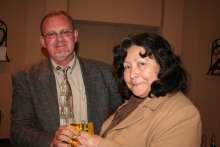SAEON pays tribute to its champions
|
As part of its Planning Meeting, a special dinner was held to pay tribute to SAEON’s guests of honour - Marjorie Pyoos and Dr Graham Baker - for their sterling contributions to SAEON’s success.
Dr Graham Baker, Editor of South African Journal of Science, was honoured for his major contribution to the special SAEON edition of the publication in which research papers presented at the first SAEON Summit in 2006 were published. The South African Journal of Science is the official publication of the Academy of Science of South Africa.
SAEON commissioned an extra 1 000 copies. Most of these were distributed at the Intergovernmental Group on Earth Observations’ Ministerial Summit to a national and international audience consisting of leading scientists and decision-makers in the field of environmental and observation science, and elicited favourable comments from the recipients.
When SAEON advertised free copies of the Journal in the February issue of SAEON eNews, the remaining copies were snapped up, and orders were even received from abroad.
In his tribute Johan Pauw, Managing Director of SAEON praised Dr Baker for the highly professional way in which the project was managed, and for his significant contribution to science throughout the years.
Marjorie Pyoos, Deputy Director-General of the Department of Science and Technology and former SAEON Advisory Board member, was honoured for her mammoth contribution to the establishment and further development of SAEON.
In his tribute, Johan referred to her as “SAEON’s godmother” and said that SAEON wouldn’t have been where it is today without her.
Marjorie, in turn, thanked Johan for the role he has played in the establishment, strategic direction and leadership of SAEON. She said that SAEON was born in a politically difficult era, and it took someone with Johan’s unique talents and dedication to breathe life into it.
“He has been the true champion of SAEON,” she said, “working across government and higher education institutions to get the fledgling network established, and going out of his way to attract the best possible talents into the organisation.”
She explained that her role has mainly been to give encouragement to SAEON and its staff, and to keep SAEON abreast of what government expects from its agencies.
She told guests that DST had embarked on a course of structured transformation encapsulated in its Ten Year Innovation Plan, a high-level presentation of the principal challenges identified by the DST.
The purpose of this Plan is to help drive South Africa’s transformation towards a knowledge-based economy, in which the production and dissemination of knowledge leads to economic benefits and enriches all fields of human endeavour.
The Plan identifies “Grand Challenges” to address an array of social, economic, political, scientific, and technological benefits. These challenges are designed to stimulate multidisciplinary thinking and to challenge our country’s researchers to answer existing questions, create new disciplines and develop new technologies.
Of specific relevance to SAEON and the work that the Network is doing, is the Grand Challenge in Global Change. Some environmental changes relate to issues broader than climate change, hence the project was scoped in terms of global change - not only in South Africa, but also in the rest of the world. “A shift in tectonic plates reverberates across the planet,” she explained, “and what happens in the northern hemisphere can have a significant impact in the southern hemisphere – most natural systems are closely interlinked.” She also said that South Africa’s geographic position enables it to play a leading role in climate change science.
“Our Science Plan is being scoped to engage with the Grand Challenges,” she explained, “and this cascades downwards – SAEON is expected to engage with every node active in global change science and observation.”
Referring to the SAEON Nodes, she said that she had been instrumental in defining criteria for the establishment of the Nodes. She said that the Nodes are crucial players in the Network as they are responsible for ensuring that the requirements of each biome are understood and catered for. “We need to evaluate SAEON’s views of what each node should be responsible for to incorporate that into the Ten Year Science Plan,” she added.
With a view to the future, DST wants to start tracking a 50-year time frame, but first they need to unpack the finer details such as how many scientists are going to be developed through this Plan, etc.
“And this is where SAEON can play a major role – by providing the information we need to populate our science plan,” she concluded.
Johan also mentioned the prestigious Prism award that SAEON won for the launch of its Egagasini Node at the Public Relations Institute of Southern Africa’s awards function this year. He thanked Mitzi du Plessis for her contribution to the success of the launch.
Selected guests at the dinner included Dr Elisabeth Lickindorf, Editor of Quest magazine and spouse of Dr Baker, and the Department of Science and Technology’s Imraan Patel, General Manager: S&T Social Impact and SAEON Board member, Leluma Matooane, Director: Climate Change, Kgoale Mphahlele, Deputy Director: Science and Technology Expert Services and Kogilam Iyer, Deputy Director: Climate Change.
| "Dr Graham Baker has been a prominent figure in the South African science system, and pivotal in producing a scientific journal of world-class international standards.” – Marjorie Pyoos, Deputy Director-General of the Department of Science and Technology. |












